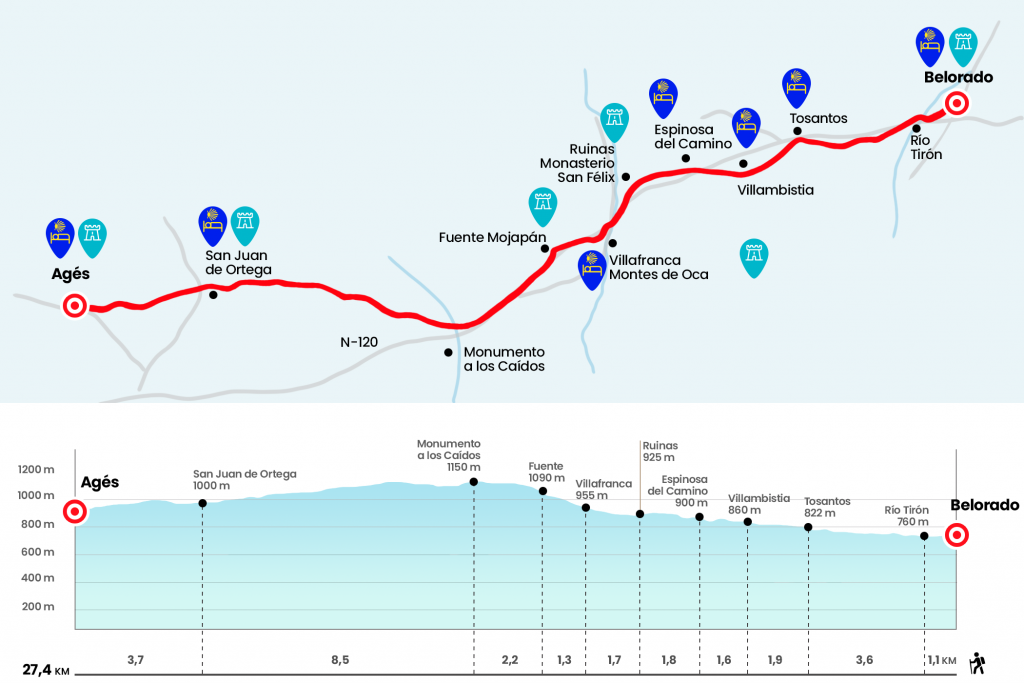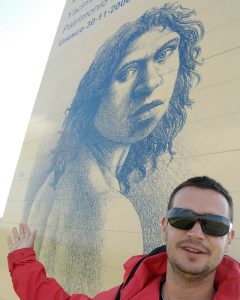Article translated by an automatic translation system. Press here for further information.
Belorar to Agés
While the first part has services, the last part does not
Information about the stage 11: Belorar to Agés

Enlarge map
Points of interest in the stage 11: Belorar to Agés
The route
- Km 0. (All Services)
To leave Belorado you have to cross Calle Hipolito López Bernal and Avenida Camino de Santiago to then cross the N-120 and the River Tirón by a wooden pedestrian bridge (Km 1.1). Parallel to this is the stone bridge known as El Canto. On a runway separated from the N-120 by the flow of the Retorto, flowing from the Tirón, we moved comfortably to the Tosantos. Just before arriving there is a rest area with several tables and barbecues.
- Km 4.7. Tosantos (Hostel. Bar)
When crossing the population you can see, on the other side of the N-120, the hermitage of the Virgen de la Peña, nestled in a rocky beetle. From Tosantos a short section brings us closer to the following population: Villambistia
- Km 6.6. Villambistia (Hostel. Bar)
We receive the parish church of San Esteban from the 17th century. A legend attributes powers to the water flowing from the four-year source. He says that to restore vitality and end tiredness there is nothing better than to soak his head in it. Past Villambistia, with nothing but a review, we headed towards Espinosa del Camino, to which we arrived after crossing the N-120.
- Km 8.2. Espinosa del Camino (Hostel. Bar)
At the exit the profile of the runway worsens slightly and reaches the ruins of the Mozarab monastery of San Félix, where tradition places the mortal remains of Count Diego Rodríguez Porcelos, founder of Burgos (Km 10). After the ruins, the itinerary rotates left in search of the arcén de la Nacional, which leads us to Villafranca Montes de Oca.
- Km 11.7. Villafranca Montes de Oca (Hostels. Hotel. Bar. Store)
From this population to San Juan de Ortega median 12 kilometers or almost three hours of walk, so it is advisable to stop for lunch or make a collection of food for the crossing of the Montes de Oca. They once constituted a risky place where the dangers waited after each shrug, but today, despite being a very lonely stretch, they offer nature and peace. We left the N-120, we climbed next to the church of Santiago - it keeps a baroque size of the Apostle - and went next to the one that was the hospital of the Queen or of San Antonio Abad. The start is steep and should be taken calmly. The calvary continues until it reaches a viewpoint on the mountains of the Demand and San Millán and the fountain of Mojapán, where the climb starts to soften (Km 13).
Surrounded by robles, juniors and breezes, the trail continues its ascent, first to a repeater and then to a monument to the fallen during the Civil War (Km 15,2). Then the runway descends like a slide down to the riverbed to face a hard, though short, I repeat. From now on, the loose gravel trail becomes a large forest track surrounded by repopulated pine forests, for which we solve the remaining seven and a half kilometers until we reach the monastery of San Juan de Ortega.
- Km 23.7. San Juan de Ortega (Hostel. Rural Tourism Centre. Bar)
The set of buildings have been of cultural interest since 1931 and belong to the municipality of Barrios de Colina. The saint Burgese Juan de Ortega (1080-1163) was a disciple of Santo Domingo de la Calzada and collaborated with him in the construction of bridges and roads before traveling to Tierra Santa. On the return he built in the same place that we find a church under the advocation of San Nicolás de Bari. According to José María Lacarra in the second volume of Pilgrimages to Santiago de Compostela: "In his will, written in 1152 and preserved in Ortega as a precious relic, he recalls the building of the church of St. Nicholas, how they inhabited thieves there and how he instituted a community of regular canonigos of St. Augustine". Inside the church there is a Romanesque captain who receives the light that sneaks through an ojival window only the days of equinox: March 20 and September 22. In San Juan de Ortega there is a bar and parish hostel and for the most sibarite a rural tourism center with all the amenities.
We left the monastic ensemble and reached an autonomic road where a wooden cross rose. There is a historical but barely transited variant that continues to the left by Santocoming de Oca, Zalduendo and Ibeas de Juarros. We go ahead and take the path that goes through a wild pine forest, no loss, towards Agés.
- Km 27.4. Agés (Hostels. Store. Bar)
The difficulties
Remarks
In images
What to see, what to do
The hostels

¿Do you want to send any photo of "The Camino de Santiago"?
If you have any photos of "El Camino de Santiago" that you want to share with us, you can send them to us and enlarge the photo gallery


Forum: What pilgrims think about the Camino de Santiago
See all